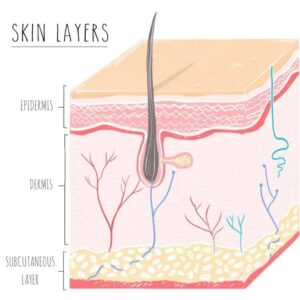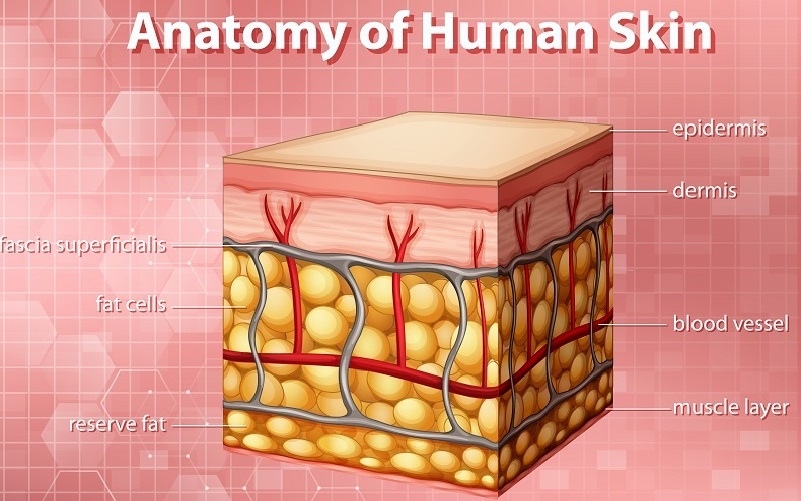When you think of your skin, you’re probably envisioning what’s only visible to you—the surface of your skin. But much that happens there, like acne, dryness and even sweat, is impacted by reactions and activities deep within the skin. Skin is actually the largest organ in the body and forms the first line of defence. In a 70 kg individual, the skin weighs over 5 kg and covers a surface area of approximately 2 square meters .
Skin has three primary layers, and each serves its own purpose. They are
- Epidermis
- Dermis
- Subcutaneous layer

The Epidermis
The epidermis is the outer layer of skin, and you can think of it as the body’s first line of defense against bacteria, viruses and even the environment. But it’s not just one uniform layer! To cover all of its responsibilities, the epidermis is actually comprised of four thinner layers:
- The topmost layer is the stratum corneum, and it varies in thickness depending on where it is on the body (which is why, say, the skin on your heel is much thicker than that of your eyelid).
- The next layer is the stratum granulosum. The cells here produce a waxy material that makes your skin waterproof.
- Next up is the stratum spinosum, which is made up of cells that bind other cells together—like glue for your skin cells.
- The bottom layer of the epidermis is the stratum basale. It houses the stem cells, which divide to produce new skin cells. Those are then pushed up to the skin’s surface.
- There is an extra layer of epidermis in palms and soles called stratum lucidum. The epidermis of these two areas is known as “thick skin” because with this extra layer, the skin has 5 epidermal layers instead of 4. Stratum lucidum is clear layer of dead skin cells present between the stratum granulosum and stratum corneum.
The Dermis
The dermis is where much of the magic happens—in the skin, at least. Collagen and elastin make up the majority of the dermis, as well as fibroblasts (the type of cell that creates the collagen and elastic tissue). This layer serves a few purposes:
- The dermis layer includes blood and lymph vessels, which are in charge of delivering nutrients to your skin and removing by-products or toxins.
- Sweat glands live in the dermis. They emit sweat through your pores, which serves to both cool the body and clear out toxins.
- The dermis also houses the hair follicles (where your hair is anchored) and oil glands, which produce the oil that softens and smoothes skin—sometimes a little too enthusiastically, resulting in breakouts and greasiness.
The Subcutaneous Layer
This layer of fat is the deepest layer of skin, and it basically attaches your bones to your muscle and bones. It’s so deep, in fact, that active ingredients from your skin care products will never reach it. This layer has a few vital duties:
- The subcutaneous layer is like a thermostat. It insulates the body and also serves as an energy reserve in a pinch.
- It’s also like padding in that this fat protects your muscles, bones and organs against injury.
- Finally, the subcutaneous layer contains more blood vessels, nerve endings, the roots of your hair follicles and the deepest sebaceous glands, which create oil.
Apart from these layers, there are many skin-associated structures known as skin appendages which serve particular functions like sensation, contractility, lubrication and heat loss. They are hairs, arrector pilli, sebaceous glands, sweat glands and nails.







